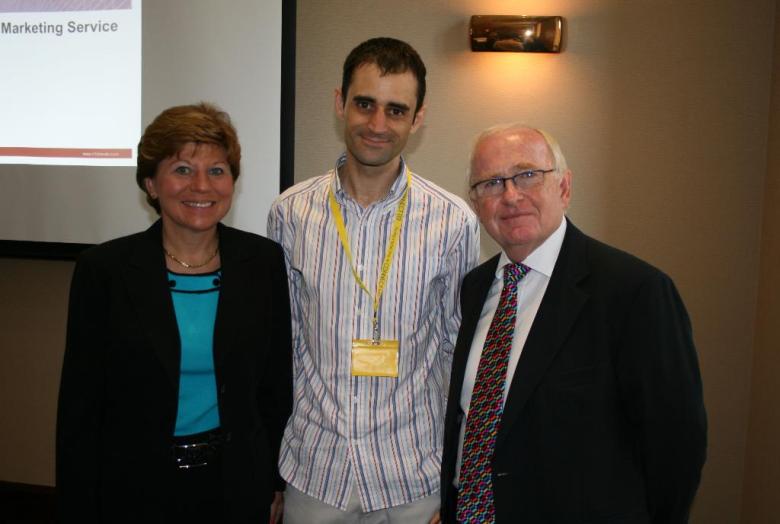
Held at the Sofitel Wentworth, the forum featured presentations and a master-class from InfoTrends’ Barb Pellow and Attributes Associates managing partner Andy Tribute.
The call to leverage old ideas was made by Pellow, who cited the David Murray tome Borrowing Brilliance to illustrate how businesses don’t necessarily need to be great innovators to be successful.
Both Pellow and Tribute were keen to emphasise that whilst print is under threat right now, it does have a future.
“Print is not dead, it’s still an integral part of any marketing campaign,” Pellow claimed.
Pellow and Tribute opened their respective presentations with a look at some of the challenges facing print, in particular the rise of internet and digital technologies.
“The biggest problem right now is reaching consumers,” Pellow said.
Pellow pointed to how young people consume multiple media – “you can talk to them when they’re on their iPod and texting someone whilst watching television, and you don’t know what messages will get through”, she observed. However, she pointed out that even older people often use conference calls to get through their emails.
“The real problem statement is reaching the unreachable consumer, given the media mix they’re dealing with every day,” Pellow said.
The multi-media trend is particularly acute in Australia, Pellow claimed, quoting research which found that 41 per cent of Australians access the internet from their mobile phone, with mobile use in general achieving 102 per cent penetration in the local market.
“There is an entire generation growing up with their mobile phone being their first connection to the internet,” Pellow observed.
Pellow discussed how printers can keep up with this trend by focusing on transpromo, which not only saves businesses money but introduces an extra marketing channel through which to engage consumers.
Pellow cited InfoTrends research which found that marketing campaigns were 35 per cent more effective if they included other media channels such as the internet, as opposed to print-only campaigns.
Transactional mail is one area where the transpromo approach is adopted, with Pellow revealing that consumers spend an average of two to three minutes reading each statement they receive. One company to take advantage of this trend is Best Western Hotels in the USA, which recently began using the white space on their statements for advertising.
Pellow also pointed to the example of QR (quick response) codes, which have started appearing in print advertising and packaging across the world. Locally, QR codes appeared on printed advertisements for last year’s James Bond release Quantum of Solace which – when scanned by a mobile device – automatically downloaded the movie’s trailer to the device.
Overseas, Pellow has seen even more exciting applications for the technology, particularly in Japan. One recent campaign promoting a new brand of iced tea saw QR codes placed on the labels of Coca Cola bottles. When these codes were scanned under a vending a machine, a bottle of the iced tea would be automatically dispensed.
Pellow also encouraged the audience to become engaged with the Web2.0 phenomenon, pointing out that, like it or not, “we are in a social networking world”.
“Social media is a dialogue, it’s getting people to talk to you online,” Pellow said. “Marketers want to get the conversation going, and then they want to keep the conversation going.”
Pellow also touched on the rise of ‘augmented reality’ in media. One example was seen at the recent Frankfurt Book Fair, where children were clamouring to see a book which, when viewed with a special set of glasses, displayed a video-like image of a volcano exploding
“Guys, you can print that,” Pellow said. “It’s a print product with a set of goggles.”
Tribute picked up Pellow’s theme of looking for new ways to engage consumers, claiming that the growth of print is always “in the printing of things that haven’t been printed before”.
Tribute didn’t pull any punches in listing the challenges facing print, with the trend towards online the most potent.
“There’s all sorts of printing work that is gone and will never be done by print again,” he said. “They’re just done better electronically.”
Tribute also cited the growth of e-readers as a threat to print, saying he believes that the technology will find a niche in the education market, echoing California governor Arnold Schwarzenegger’s push to phase out hefty school textbooks.
Tribute also discussed the inherent business problems facing printers, describing print as “a high-risk and low-margin” trade that is currently suffering under the burden of over-capacity, which has resulted in a buyers’ market, pushing prices down.
There is also the challenge of cheap competition from the emerging Asian markets, with Tribute reporting a surprising wealth of quality coming out of the Indonesian and Thai markets in particular.
Comment below to have your say on this story.
If you have a news story or tip-off, get in touch at editorial@sprinter.com.au.
Sign up to the Sprinter newsletter

